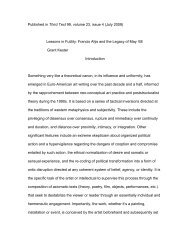Old Masters and New Lessons - Grant Kester
Old Masters and New Lessons - Grant Kester
Old Masters and New Lessons - Grant Kester
Create successful ePaper yourself
Turn your PDF publications into a flip-book with our unique Google optimized e-Paper software.
morals of others, but by the aesthetic nature we have made our own.(35)<br />
One can postulate ideal forms of society endlessly, but without also engaging the difficult<br />
questions raised by how these models might be applied, they remain ineffectual abstractions. On<br />
the one h<strong>and</strong>, the aesthetic provides an autonomous refuge or sanctuary apart from<br />
instrumentality <strong>and</strong> self-interest. At the same time, the aesthetic serves as a kind of navigational<br />
marker toward the telos of a society that is united in a non-coercive common sense. But the very<br />
disengagement from the object (<strong>and</strong> by extension, from worldly concerns) that provides the<br />
disinterested outlook with a perspective from which to criticize existing social values (<strong>and</strong> from<br />
which to imagine something better) also prevents it from engaging in any concrete way with the<br />
forms of political <strong>and</strong> social power that maintain, <strong>and</strong> are maintained by, those values. The<br />
principle of an Enlightenment aesthetic is denied any means of practical or empirical application.<br />
Its effects can be produced only in the realm of ideas, <strong>and</strong> the actual transformation of society<br />
remains a teleological principle rather than a practical goal.<br />
This issue seeks to challenge the disengagement of the aesthetic from political discourse<br />
not by denying the knowledge produced by the body <strong>and</strong> the senses, but by analyzing the ways<br />
in which this knowledge both resists <strong>and</strong> collaborates with forms of social, cultural, <strong>and</strong> political<br />
power. In place of a preoccupation with beauty the following essays might be said to concern<br />
themselves with the political economy of the aesthetic. Dunn <strong>and</strong> Leeson call for a new<br />
"aesthetics of collaboration" based on "interdisciplinary approaches to change in our<br />
environment, culture, <strong>and</strong> communications." Susan Buck-Morss discusses the "anesthetizing"<br />
effect of modern culture, which works to suppress our bodily capacity for "critical cognition." She<br />
rejects the idea that sense-based experience can be partitioned from a political consciousness,<br />
arguing instead that "cultural meanings are sensed bodily as being wrong." "How else," argues<br />
Buck-Morss, "are people capable of social protest? . . . I want to say that aesthetics is the body's<br />
form of critical cognition, <strong>and</strong> that this sensory knowledge can <strong>and</strong> should be trusted politically."<br />
Greig Crysler <strong>and</strong> Abidin Kusno suggest that Hickey's "therapeutic institutions" (even those with<br />
no particular interest in "art" per se) are quite capable of deploying aesthetic techniques that<br />
engage the viewer on the level of somatic or bodily experience.(36) Thus, the Holocaust




